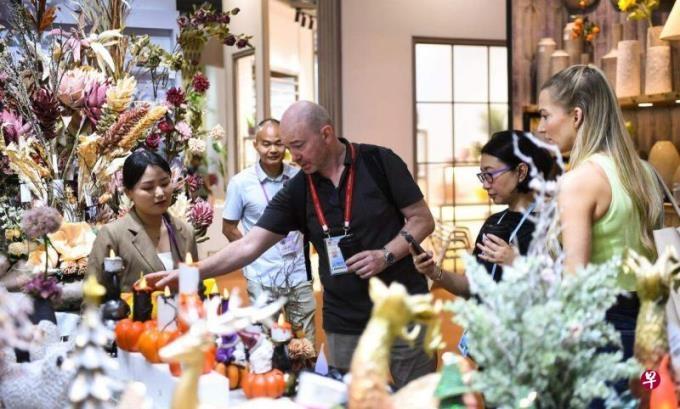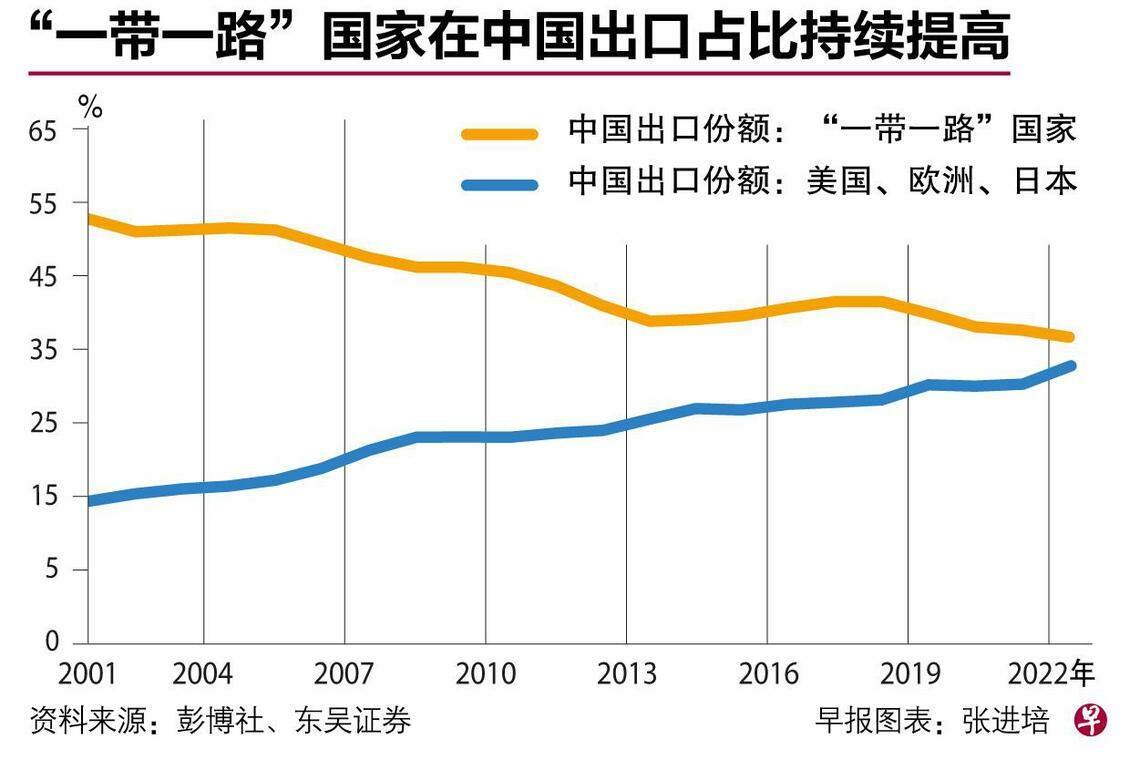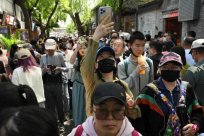
"We have more than a dozen container orders to catch up. Recently, all employees are working overtime, and 70 temporary workers are invited."
The director of the Biyu Cosmetics Accessories Company, located in Shenzhen, Guangdong, told Lianhe Zaobao that the export order received by the company this year has increased by nearly 40 % compared with the same period last year.Delivery work.
The makeup brush produced by Biyu is mainly sold to markets such as the United States, Europe and Japan.Wujiang disclosed that the above market orders have increased, and the export volume is expected to return to the level before the epidemic."The epidemic passed, and everyone's demand for makeup was back. I told the employees that we have to earn the three years of lost time."
The influence ofThe impact of the crown epidemic on China's manufacturing has gradually faded, causing the business of foreign trade manufacturers such as Biyu to bottom out, and it is intuitively reflected in export data.According to data from the General Administration of Customs, the export value of the US dollar increased by 14.8 % year -on -year, ending the previous five consecutive months of decline.
 />
/>
The increase in exports in March not only broke market expectations, but also drove China's exports to stop falling back in the first quarter of this year, an increase of 8.4 % year -on -year.In the first quarter, China's economic growth also climbed to 4.5 % driven by this dark horse, which was better than analysts' prediction of 4 %.
However, there is a significant gap between export growth and other related data, which has also triggered controversy and questioning.For example, South Korea and Vietnam, which have high exports to China, decreased by 13.6%and 13.2%year -on -year exports.In addition, after the Spring Festival this year, the accumulation of air containers and other ports in Shanghai, Zhejiang, and other ports also caused concerns about China's foreign trade.
The Director of the General Administration of Customs, Yu Jianhua, responded at the end of March. The reasons for the accumulation of containers include the large amount of new containers in the previous period, the low domestic stacking costs, and the short -term reflux of the short -term aircraft in the short -term aircraft after the foreign epidemic was relieved.Most analysts agreed with this view that despite the decline in external demand, the overcapacity of air containers in the past two years is the main reason for the accumulation of empty boxes.
The latest report of CITIC Futures Research also pointed out that after entering April, the situation of the empty box was relieved, the freight rate of international containers had stopped falling back, and the freight rates of multiple routes in Asia and Africa increased by 20 % compared with the average value of 2019.
Guo Lei, the chief macro analyst of Guangfa Securities for China's export performance in March, believes that this is mainly because the Korean export product chain is too concentrated in consumer electronics and semiconductor products.In the same period of the same period of Chinese exports, these products also performed downturn due to the downward impact of global needs. Instead, labor -intensive products such as bags, clothing, and "new three" (electric vehicles, lithium batteries, solar batteries) became the main force of export growth.Essence
Compared with Vietnam, which is also based on labor -intensive products, China's export performance may be better because it is released in the early period of backlog order.
Zhai Suo, chairman of Dongguan Guangsheng Hardware Plastic Products Co., Ltd., said in an interview that the epidemic was gradually fading at the beginning of this year, and then encountered the Spring Festival holiday, resulting in the early backlog order concentrated to March."But this situation will not last for a long time, and the business will be faded after the business is done."
A variety of products such as toys and wireless radio frequency recognition systems (RFID) labels produced by Guangsheng are mainly sold to the European and American markets.Zhai's leader said that after the outbreak of the Russian and Ukraine War last year, orders from Europe have decreased significantly; this year's orders in the United States have also reduced by about 20 %, and both ends of supply and demand have weakened.
On the supply side, the US Federal Reserve ’s interest rate hikes have led to an increase in the cost of retail enterprises. Enterprises reduce their procurement in order to reduce inventory. On the demand side, economic downturn has reduced consumers' purchasing power and invested more low -cost products.Zhai Zao was worried that the Federal Reserve's interest rate hike will promote American customers to continue to reduce orders.
Southeast Asia in Russia becomes a new growth momentum for exports
In the context of relatively low demand for developed economies, Russia and Southeast Asia have become the new growth driving force for China's exports.In March, China's export growth rate for Russia was as high as 136.4 %, and the exports of Asia in Asia also rose by 35.4 %, an increase of 27.1 percentage points from the previous month.
Soochow Securities data shows that in the past 10 years, the "Belt and Road" countries have increased from 25 % to 32.9 % of the exports of China, the largest increase in Asia's Danian, and the contribution of the traditional export focus market in Europe, America and Japan has continued to declineEssenceTao Chuan and Shao Xiang of Soochow Securities predict that in the context of Sino -US competition, the Belt and Road countries will gradually replace Europe, America and Japan, and become the most important trading partners in China.

Xie Dongming, director of the Greater China Research Director of the Overseas Chinese Bank of Singapore, pointed out that although Asia Jiajian is currently the largest trading partner in China, it accounts for only 15.8 % of China's exports and less than 16 % of the United States."If the global economy falls, it is difficult for Southeast Asia to be alone. With Russia and the Belt and Road countries alone, it is difficult to offset the impact of the decline in the demand in Europe, America and Japan."
Xie Dongming further predicts that the exports in March are high and very good, and China's exports are likely to fall again in the second quarter."The surface of the surface in March could not cover the decline of the European and American economy. The data of the Canton Fair in April also showed that European and American orders did not increase significantly. This is not good news for China exports."
The Canton Fair opened in mid -April, the exhibition area and the number of exhibitors reached a new high, but the survey of the 15,000 exhibitors of the 15,000 exhibitors currently recovered shows that the decline in orders and insufficient demand are still the main difficulties facing enterprises.Wang Shouwen, deputy minister of China, frankly said at the press conference of the Canton Fair that the survey results were consistent with official expectations, reflecting the severe and complexity of the foreign trade situation this year.
The WTO predicts that the global cargo trade will increase by 1.7%this year this month, higher than the previous forecast of 1%, but it is still lower than the growth rate of 2.7%last year.Although the level of inflation seems to be alleviated, the Federal Reserve will probably raise interest rates again in May to further suppress consumers' needs.Officials of the International Monetary Fund (IMF) also warned that although the European economy has been acceptable recently, the overall growth trend is weakening, facing the challenge of curbing inflation, maintaining economic recovery, and maintaining financial stability.
The spokesperson for the China Customs General Administration, Lu Daliang, pointed out that the external environment facing China's foreign trade this year is still severe and complicated. The main constraints are weakened external needs, and at the same time, the impact of geopolitics is superimposed.
Sino -US relations are tightly ordered foreign companies to press down
In addition to weak foreign demand, the continuous and tense geopolitical situation is another Damocaris sword hanging on the head of Chinese foreign trade enterprises.
Philip Richardson, an American businessman who supplies audio equipment in the European and American markets, complained that Sino -US relations have continued to deteriorate, and products made in China have also been under pressure."American politicians and media continue to ugly Chinese image and call on American companies to move out of China.Our customers put a lot of pressure."
Sun Bowen operated a audio equipment factory in Panyu, Guangdong. As the backlog order was basically delivered, he decided to take a seven -day long vacation for the workers during the "May 1st" holiday.Compared with the decrease in orders at the moment, he is more worried that Chinese issues will continue to rise with the approaching of the US presidential election next year, causing the United States to further target products from China.This also made him determined to develop more product lines and reduce the risk of excessive relying on single products.
The Premier Li Qiang of the State Council of the State Council emphasized at the executive meeting of the State Council in early April that in order to try to stabilize exports to developed economies, guide enterprises to further develop the market markets such as developing countries and regional markets such as Asia in China (China -called ASEAN), and make full use of foreign trade provincesThe role of stabilizing the main force of foreign trade and encouraging all localities to introduce supporting support policies for local conditions.
Faced with the continuous pressure of foreign trade, the provinces and cities in China have successively organized corporate charter machines to grab orders from the fourth quarter of last year. The United States, Europe and Southeast Asia have become the main destinations of Chinese business groups.
Wujiang went to Singapore to participate in the Asia -Pacific Beauty Show in November last year. In March of this year, he flew to Bologna, Italy to participate in the exhibition. Next, he planned to go to Japan, France, the United States, and Morocco to make up for the international exhibition for three years to make up for all the time.EssenceHe specially arranged for the United States for more than half a month and met with new and old customers along the way.
He said: "Chinese people pay attention to meeting three points. Now the Chinese and American trade detachment theory is very arrogant. As a foreign trade enterprise on the top of the limelight, we must strengthen contact with US customers.Your own competitive advantage. "
Consumption and investment bearing more important role

With the weakening prospects of the exports of China's economy in the past three years, consumption and investment in the Chinese economy's "carriage" has shot a more important role.
After relaxation of epidemic prevention control in China, the consumption demand rebounded sharply in the first quarter of this year, and the contribution rate of consumption expenditure to economic growth in the end reached 66.6%.However, the growth rate of fixed asset investment during the same period is lower than the previous value and market expectations, adding more uncertain factors to the road of economic recovery.
Like the sluggish folk investment, China's foreign investment situation is not optimistic.According to data from the Ministry of Commerce of China, in 2022, Chinese foreign direct investment (FDI) was 190.3 billion US dollars (below, Same was S $ 253.9 billion), which was significantly lower than US $ 334 billion in 2021 and US $ 253.1 billion in 2020.Considering the data balance table (BOP) data of foreign capital withdrawal factors, it is more severe than the data of the Ministry of Commerce.
Joerg Wuttke, chairman of the Chinese EU Chamber of Commerce, pointed out at a press conference last week that the European Union's investment in China was nearly $ 10 billion last year, doubled from the previous year.However, if the German car company BMW BMW has invested in the construction of Shenyang Factory for two years due to an epidemic, the EU's investment in China actually reduced 40 % year -on -year.
Since this year, Chinese governments have successively introduced optimized business environment policies and increased their efforts to attract people and overseas investment.When leaders of Chinese senior leaders receive Singapore, France, the European Union and other countries and regions, they will also strengthen economic and trade cooperation as one of the key points of talks.
On the other hand, after China reopening the border earlier this year, international exhibitions such as the Canton Fair and the Shanghai Auto Show once again ushered in a large number of overseas exhibitors, and new investment also followed.During the just ended Shanghai Auto Show, the public of German car companies announced the establishment of an electric vehicle research and development and procurement center in China.
Foreign business interviews pointed out that although they are still optimistic about the huge potential of the Chinese market, production in China is blocked during the epidemic, and the geopolitical situation is becoming increasingly tense, which has made them more cautious about investing in China.
Jens Eskelund, Vice Chairman of the EU Chamber of Commerce, told the United Zard that before the outbreak of the crown disease, China was favored by European companies with a high -level manufacturing industry and a stable and predictable high -efficiency supply chain.However, the interference of the supply chain for three years of epidemic prevention sealing has forced European companies to explore decentralized production bases to reduce risks."We must (and the Chinese government) carefully discuss how to reshape the toughness of the supply chain, so as to avoid the chaos last year from happening again."
The EU Chamber of Commerce will issue a investigation of business confidence in European European companies in June this year.Woodkek disclosed that the proportion of companies willing to stay in China decreased from 41 % last year to 35 %, and companies planned to set up production bases outside China increased from 8 % to 10 %.
The latest survey released by the American Chamber of Commerce last week shows that 109 interviews are optimistic about the prospects of China among Chinese companies, but 87%are pessimistic about the current Sino -US relations, which is 14 more than half a year ago.percentage point.27%of the interviewed companies are re -consideration to transfer the supply chain to other countries, an increase of 21 percentage points over the last survey.
In addition to hoping that Chinese officials will increase their opening up, foreign companies are also looking forward to boosting the confidence of consumers and private enterprises and creating a more active domestic market.
Yan Ci believes that the Chinese government's policies are more inclined to export -oriented industries such as manufacturing and have insufficient support for domestic demand.In the face of severe employment situation, how long the consumer demand rebound can last, it is still unknown, which will also affect foreign companies' investment confidence.
Craig Allen, president of the National Committee of the United States and China Trade National Committee, also emphasized that if the private economy was better developed and fairly treated in March, it will invest in ChinaInject a dose of strong needle.He said that foreign capital was happy to see "a better balance between Chinese -owned enterprises and the private economy."



